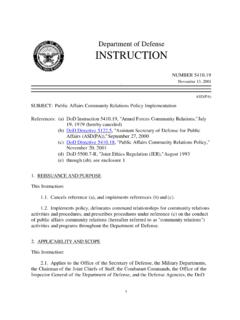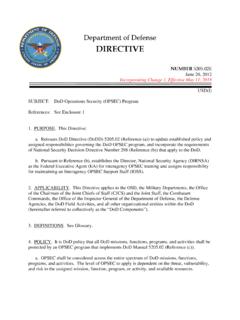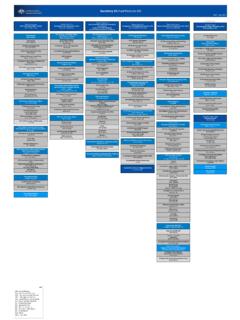Transcription of .F’ w Advisory Circular - Federal Aviation Administration
1 F w Department of Transportation Federal Aviation Administration Advisory Circular Subject: MINIMUM EQUIPMENT REQUIREMENTS Date: 6/28/91 AC No: 91-67 FOR GENERAL Aviation operations Initiated by: AFS-820 UNDER FAR PART 91 1. PURPOSE. This Advisory Circular (AC) describes acceptable methods for the operation of aircraft under Federal Aviation Regulations (FAR) Part 91 with certain inoperative instruments and equipment which are not essential for safe flight. a. These acceptable methods of operation are: (1) Operation of aircraft with a Minimum Equipment List (MEL), as authorized by FAR 6 (a). (2) Operation of aircraft without an MEL under FAR 8 (d).
2 B. This AC also explains the process for obtaining Federal Aviation Administration (FAA) approval of an MEL. 2. RELATED FAR SECTIONS. The following FAR provide additional information on operations with or without a FAR Part 91 MEL: a. FAR 5 : Content, form, and disposition of maintenance, preventive maintenance, rebuilding, alterations, and alteration records (except inspections performed in accordance with FAR Parts 91, 123, and 125 and FAR 56 135411(a)(l) and ). b. FAR 5 : Content, form, and disposition of the records for inspections conducted under FAR Parts 91 and 125 and FAR 05 135411(a)(l) and c.
3 FAR 0 : Powered civil aircraft with standard category airworthiness certifi- cates: Instrument and equipment requirements. d. FAR 8 : Maintenance required. 3. FORMS AND REPORTS. The FAA Flight Standards District Office @DO) contacted by an MEL applicant provides the applicant a Master Minimum Equipment List (MMEL) for the applicant s particular aircraft. 4. RELATED READING MATERIAL. Users of this AC will find detailed background and indepth information in the FederaI Register, Vol. 53, No. 239, December 13, 1988. The public may obtain copies of this issue of the Federal Register from the FAA, Office of Public Affairs, Public Inquiry Center, APA-230, 800 Independence Ave.
4 , SW., Washington, DC 20591. AC -!% 67 \ 6/28/g! 5. BACKGROUND. Except as provided in FAR 8 , all instruments and equipment installed on an aircraft must be operative in order for the operator to operate it. However, the FAA recognized that safe flight can be conducted under the MEL concept and under specific conditions with inoperative instruments and equipment.. a. Regulatory History. Until the most recent change to FAR 8 , the MEL concept applied only to air carrier and commercial operations and general Aviation operators of multiengine aircraft for which FAA had developed an MMEL. Operators of aircraft for which FAA had not developed an MMEL had to comply with FAR 0 This section required that all aircraft discrepancies occurring between required inspections had to be repaired in accordance with FAR Part 43 before the air- craft could be operated.
5 This meant that all the aircraft s instruments and equipment, regardless of whether they were essential or not to the flight operation conducted, had to be operative. , This requirement often placed a burden on operators. b. Amendments to FAR Part 91. Over the past decade, the FAA initiated several rulemaking projects to alleviate the regulatory burden of FAR 0 Before the issuance of a final rule change, FAA encouraged public and industry participation, accepted and reviewed public comments, and conducted public hearings which were attended by other Government agencies and the industry. (1) The FAA briefly suspended FAR 6 and allowed issuance of MEL s by exemption.
6 During this period, the FAA gained valuable information on the usefulness and safety aspects of using MEL s in general Aviation . (2) Further, general Aviation operators have a history of safe operations using FAR 5 as the sole reference for determining the instrument and equipment requirements for a particular flight. (3) However, operators indicated the need for relief from FAR 8 , and the FAA agreed that the FAR should reflect current operational practices. Consequently, the FAA amended FAR Parts 43 and 91 in December 1988. c. New Reguliztory Requirements: The amendment to FAR Parts 43 and 91 provides a regulatory basis for the operation of aircraft with inoperative instruments and equipment.
7 Opera- tors conduct these operations within a framework of a controlled program of maintenance inspec- tions, repairs, and parts replacement. However, operators must exercise good judgement and have, at each required inspection, any inoperative instrument or equipment repaired or inspected or the maintenance deferred, as appropriate. 6. DEFINITIONS. a. Aircraft Evaluation Group (AEG). The AEG is the FAA office responsible for the development and publication of an approved MMEL for those aircraft within its area of responsibility. b. Aircraft Flight Manual (AFM). The AFM is the source document for operational limitations and performance for an aircraft The term AFM can apply to either an airplane flight manual or a rotorcraft flight manual.
8 FAA requires an AFM for type certification. The responsible FAA Aircraft Certification Office (ACO) approves an AFM. ii Par 5 6/28/91 AC 910 67 c. Aircraft Maintenance Manual (MM). The AMM is the source document for maintenance procedures for an aircraft. The term AMM can apply to either an airplane maintenance manual or a rotorcraft maintenance manual. FAA requires the AMM for type certification. d. Airworthiness Directive (AD). An AD is a mandatory airworthiness requirement for a particular make and model aircraft or installed equipment. An AD is supplementary to the- aircraft original airworthiness approval.
9 E. Air Transportation Association (ATA) Numbering System. The standard ATA numbering system refers to systems on different aircraft in a standardized manner. MMEL s use the ATA numbering system.. J Calendar Days include all days, with no exclusion for weekends. and holidays. g. Deactivation means to make a piece of equipment or an instrument unusable to the pilot/crew by preventing its operation. s h. Deferred Maintenance is the postponement of the repair or replacement of an item of equipment or an instrument. i. Equipment List is an inventory of equipment installed by the manufacturer or operator on a particular aircraft.
10 J. Flight operations Evaluation Board (FOEB). The FOEB is composed of FAA personnel who are operations , avionics, airworthiness, and aircraft certification specialists. The FOEB develops an MMEL for a particular aircraft type under the direction of the AEG. k. Inoperative means, that a system and/or component has malfunctioned to the extent that it does not accomplish its intended purpose and/or is not consistently functioning normally within its approved operating limits or tolerances. *. 1. Kinds of operations List (KOL). The KOL specifies the kinds of operations ( , visual flight rules (VFR), instrument flight rules (IFR), day, or night) in which the aircraft can be operated.















